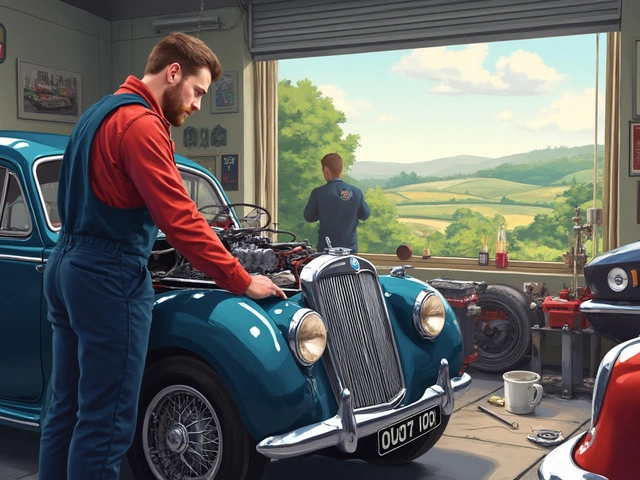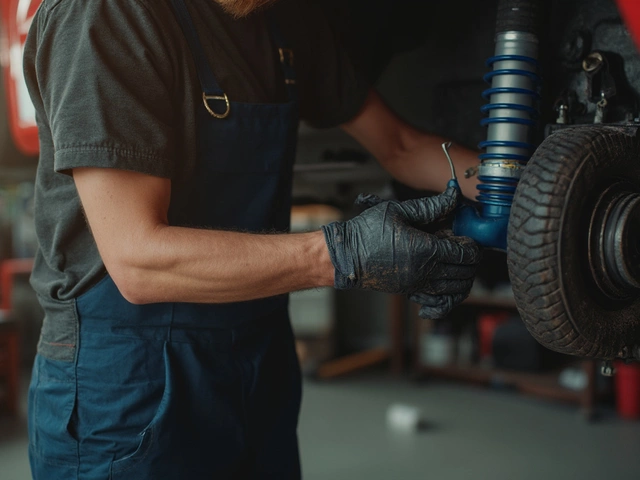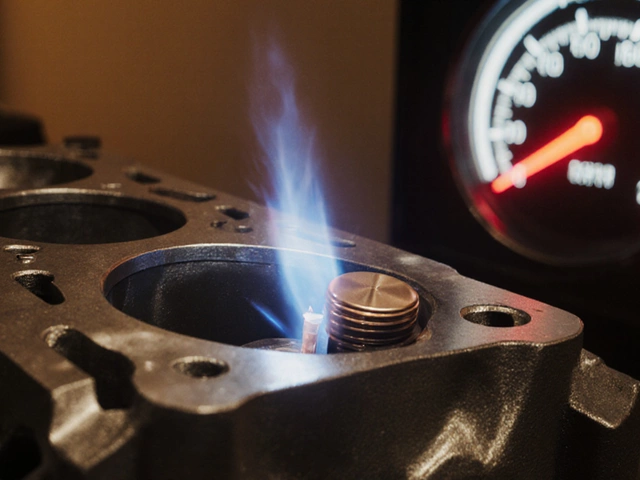If your goal is to have your car sound as mean as it looks, the muffler is the magic piece. But picking the most aggressive sounding muffler isn’t just about grabbing the loudest one off the shelf. It’s all about construction, design, and how it fits your setup.
Aggressive sound isn’t just noise—it's the deep, raspy note that grabs attention and sometimes even rattles windows. Straight-through mufflers, often called “glasspacks” or “straight pipes,” are usually the kings of raw aggression. Think Flowmaster Outlaw, Borla ATAK, or Cherry Bomb Extreme—these have barely anything inside but sound tunnels and packing material, so exhaust gases shoot right through. The result is wild volume and a harsh bark, especially at full throttle.
On the flip side, some chambered mufflers make aggression more controlled, mixing in a throaty rumble. Flowmaster’s Super 44 or American Thunder are classics here—they use baffles to shape the sound but still bring the attitude, just with more bass and less crackle.
- What Makes a Muffler Sound Aggressive?
- Straight-Through vs. Chambered: The Sound War
- Top Contenders for In-Your-Face Sound
- Exhaust Diameter and the Role of Resonators
- Street-Legal vs. Wild: Where’s the Line?
- Getting the Roar Without Wrecking Daily Life
What Makes a Muffler Sound Aggressive?
Ever heard a car growl past you and wondered why it sounds so tough? The answer is mostly in the muffler’s guts. What really makes a muffler aggressive is how it handles airflow, noise cancellation, and resonance. In simple terms, the less a muffler tries to quiet things down, the meaner it’s going to sound.
Most aggressive mufflers cut down on sound-deadening materials. Straight-through designs, for example, use minimal packing and a straight internal pipe, which lets sound waves escape fast and loud. The internal diameter of the muffler also matters—a bigger pipe usually means a deeper, fuller roar. Add in the thickness and type of steel (or even the shape of the case), and you start seeing how much the design impacts the sound.
It’s not just the muffler, though. Where it sits in the system, the number of bends in the exhaust, and even tips or turn-downs at the end shift how aggressive your ride can sound. Straight-through mufflers farther back in the system are almost always wilder than chambered mufflers placed closer to the engine.
- Aggressive mufflers usually have little to no restriction: just a perforated tube and sound-absorbing material around it.
- Chambered designs use fixed plates inside to bounce sound around, which lowers certain frequencies but can add a deep, throaty growl.
- Material matters, too: stainless steel tends to ring out sharper tones, while cheaper aluminized steel is usually a bit duller.
To put it in perspective, here’s how different muffler designs stack up:
| Muffler Type | Typical Sound | Noise Reduction |
|---|---|---|
| Straight-Through/Glasspack | Very loud, raspy, raw | Low |
| Chambered | Deep, throaty, controlled aggression | Medium |
| Turbine/Performance | Smooth, performance-tuned, less harsh | High |
If you want that aggressive edge, size, design, and material all matter. But it’s the flow and how much sound the muffler actually lets out that decides if your car roars or purrs.
Straight-Through vs. Chambered: The Sound War
If you’re after the most aggressive muffler, you’ve got two main styles fighting for the spotlight: straight-through and chambered. They may look similar from the outside, but inside it’s a totally different story. Let’s break it down so you know exactly what you’re getting.
Straight-through mufflers, also called glasspacks, are basically a straight pipe with sound-deadening material (usually fiberglass) wrapped around a perforated tube. They barely restrict airflow. This means you get max volume, pop, crackle, and an edge that’s hard to ignore. Famous choices are Magnaflow Race Series, Cherry Bomb Extreme, and Borla XR-1. You’ll often hear these on street racers and some muscle cars chasing that raw, unfiltered roar. Just know, some towns and states will bust you if it’s too loud, so check local laws before you order.
Chambered mufflers work differently. Inside, they’ve got plates and baffles that force the exhaust to bounce around. This cancels out certain sound waves and deepens others. The result? More of a classic, rumbling muscle car sound rather than full-out chaos. They still pack punch, but it’s a bit less headache-inducing. Top chambered models include Flowmaster Super 44, Flowmaster 40 Series, and American Thunder. If you want to blend attitude with daily driveability, chambered might be your style.
Here’s a quick comparison to help you pick:
| Type | Volume | Sound Character | Popular Models |
|---|---|---|---|
| Straight-Through | Very Loud | Sharp, raspy, raw | Borla ATAK, Cherry Bomb Extreme, Magnaflow Race |
| Chambered | Loud, but deeper | Throaty, bass-heavy, classic muscle | Flowmaster Super 44, Flowmaster 40 Series |
If you want every head to turn at your rev, straight-through wins the sound war. But if you want a growl you can live with on the highway, chambered is probably the safer bet. Either way, both can wake up your car—and your neighbors.
Top Contenders for In-Your-Face Sound
If you’re chasing the most aggressive-sounding muffler, the market has some big-name leaders that always turn heads—some even set off nearby car alarms with just a blip of the throttle. Let’s break down what stands out and why these models have such a huge following among gearheads who want real impact.
The aggressive muffler scene is dominated by a select few brands and models recognized for their raw output. Here are some of the crowd favorites:
- Flowmaster Outlaw Series: These are straight-through beasts, practically designed to be as loud as the law allows. No internal baffles means exhaust gases get out fast, making a ripping, metallic scream that’s especially wild on V8s.
- Borla ATAK: ATAK stands for Acoustically-Tuned Applied Kinetics, which is a fancy way of saying this thing is dialed in to pump out sharp pops and an aggressive snap. The tone is raspy and clear, not muddy, and it stays loud across the whole rev range.
- Cherry Bomb Extreme: The classic choice when people think "glasspack." Cherry Bombs have been around since the muscle car days and are popular for their old-school rawness. The Extreme model is short, straight, and pretty much unapologetic about its noise.
- Magnaflow Race Series: Magnaflow usually builds deep-toned mufflers, but the Race Series is where they cut loose. These straight-through designs favor big sound—especially if you’re running a larger diameter pipe.
- Dynomax Ultra Flo: More of a deep bellow than a pure scream, but still super aggressive on throttle. These are used a lot in drag and street cars that want volume without a ton of metallic rasp.
Want some real-world data? Here’s a comparison table of typical decibel levels for some of the most aggressive muffler models when installed on a V8 at wide open throttle. These results were measured in independent shop tests at three feet behind the car:
| Muffler Model | Typical dB (Wide Open Throttle) |
|---|---|
| Flowmaster Outlaw | 93–97 dB |
| Borla ATAK | 91–95 dB |
| Cherry Bomb Extreme | 92–98 dB |
| Magnaflow Race Series | 90–94 dB |
| Dynomax Ultra Flo | 89–93 dB |
To give you an idea, most stock mufflers usually hang out around 75–80 dB at full load on a V8. The numbers above? That’s into the territory where you’ll be heard a block away, and you’ll probably have to turn up your music. But be ready—some cities have noise limits, and these monsters can put you on the wrong side of the law if you aren’t careful.

Exhaust Diameter and the Role of Resonators
The size of your exhaust pipes matters more than most people think. If you're after that aggressive muffler sound, a bigger diameter isn’t just for looks—it actually changes how your engine breathes and how your muffler sounds. Most stock systems are around 2 to 2.25 inches, but performance setups usually jump to 2.5, 3, or even bigger. The main thing is, as pipe diameter goes up, so does exhaust volume and the chance for that deep, snappy tone. But it’s not a "bigger is always better" deal. Go too big, and you might lose backpressure, which totally kills low-end torque on many street cars.
Check out this quick look at what different pipe sizes do for sound and performance:
| Exhaust Diameter (inches) | Typical Application | Sound Character | Common Effect |
|---|---|---|---|
| 2.0" | Small engines, daily drivers | Quieter, mild tone | Good low-end torque |
| 2.5" | Street performance | Louder, deeper note | Balanced torque and top-end |
| 3.0" | Turbo or high-horsepower builds | Very loud, aggressive | Much more top-end, less low-end |
| 3.5"+ | Race cars or pure show builds | Ear-splitting, boomy | Low-end loss, mostly for bragging rights |
Resonators are another big part of this game. A lot of people think a resonator just quiets things down, but it really shapes how your exhaust "sings." Technically, a resonator targets certain sound frequencies and cancels them out, which reduces drone and hissing. But it can also bring out that deep, crackling race sound if you pick the right style or even delete them completely—tons of muscle car guys do just that for extra attitude. Just know, dropping resonators ramps up interior noise, and if you drive long distances, highway drone can get old fast.
If you want aggression but don’t want to lose your mind from the noise inside, consider a straight-through resonator. It keeps things rowdy outside but dials back the worst cabin buzz. Brands like Vibrant Performance and MagnaFlow do these well and are favorites for custom setups.
In short, play with diameter and resonator style for the sound you want, but always keep street usability in mind. Most setups hit the sweet spot around 2.5 to 3 inches with a straight-through resonator or none at all for that raw, tough sound.
Street-Legal vs. Wild: Where’s the Line?
There’s a fine line between sounding bold and getting slapped with a ticket. Just bolting on the aggressive muffler of your dreams doesn’t mean you’ll pass a road check. Different states—and even cities—have their own rules on how loud your exhaust can be. Most cops won’t even use a decibel meter, but if you’re noticeably louder than stock, you’re already on thin ice.
Here’s some straight talk: in California, state law says anything over 95 dB(A), measured from 20 inches behind the tailpipe, is illegal. New York and a few other places are similar. But in Texas, you just need a “muffler”—technically, any device to pacify noise. The chart below shows how limits compare in a few states:
| State | Max Allowable Exhaust Noise (dB) | Measurement Rule |
|---|---|---|
| California | 95 | 20" from tailpipe, SAE J1169 |
| New York | 95 | Restricted to OEM or equivalent |
| Texas | N/A | "Effective muffler" required, but no decibel limit |
| Florida | 95-99 | Varies by weight/class |
| Michigan | N/A | "Excessive or unusual noise" is subjective |
Install something wild like a Cherry Bomb Extreme or an open straight-pipe and you’ll probably break 100 dB, even at idle. Some setups with catless systems or cutouts have been measured at 120 dB or more. That’s enough to get your neighbors (and the cops) instantly annoyed.
If you want to push the envelope but avoid hassle, these tips help keep things fun and legal:
- Check your state and local noise laws before dropping cash on a new exhaust.
- If you’re in a strict area, choose a muffler with removable baffles or optional silencers—perfect for daily driving and swapping out for track days.
- Keep the rest of the system in check. High-flow catalytic converters or resonators will tame the wildness but still keep things aggressive.
- Try not to rev-bomb in quiet neighborhoods or late at night. Nothing tanks your reputation faster than waking up a block at 2 a.m.
In the end, there’s no magic number for what’s "too loud" everywhere. A decibel reading is just part of it—your exhaust’s pitch, drone, and even how it sounds at different RPMs all matter. When in doubt, talk to a local shop or tuner. They’ll know what flies and what gets towed.
Getting the Roar Without Wrecking Daily Life
No one wants to deal with headaches and complaints every time they start their engine. It's totally possible to get an aggressive muffler sound and still keep life peaceful for you—and your neighbors. You just need to make some smart choices and know a few tricks.
First, think about muffler placement. Putting a super-loud muffler right under your daily driver’s floorboards is a fast track to drone city. Mufflers placed closer to the rear often sound better outside the car and aren't as annoying inside.
Soundproofing goes a long way, too. Even something simple like trunk liner or under-car mats can block out a chunk of that exhaust rumble inside the cabin. Some owners even add a resonator or Helmholtz chamber—this hacks down those brain-crushing low frequencies without muting the aggressive bark outside.
Here’s what really helps keep things livable:
- Choose a muffler with built-in drone reduction, like Borla ATAK or Corsa Sport. These are famous for outdoor volume but mellow cabin noise.
- Avoid giant exhaust pipes unless you want serious cabin boom. Pipes around 2.5 to 3 inches are usually the sweet spot for most street cars.
- Install an electronic cutout. Flip a switch and you’ve got full race car loud; flip it back for the commute and it’s nearly stock-quiet.
- Always use quality exhaust hangers—cheap rubber ones can shake loose and amplify rattle and drone.
Curious about what levels are actually tolerable? Here’s a quick table showing average decibel (dB) levels from real setups on popular cars:
| Muffler/Setup | Outside Idle (dB) | Inside Cabin @ 60mph (dB) |
|---|---|---|
| Flowmaster Outlaw (Mustang GT) | 92 | 78 |
| Borla ATAK (Camaro SS) | 89 | 73 |
| Cherry Bomb Extreme (Charger R/T) | 94 | 82 |
| Stock OEM (Most V8s) | 74 | 66 |
Daily life is all about balance. If your car sounds awesome outside but gives you headaches inside, nobody wins. Don’t forget to check your local laws too—most places cap street dB levels at about 90–95 dB at idle and moving. Stay smart and you’ll have the best of both worlds: wake-the-neighborhood power, without the after-hours regret.






